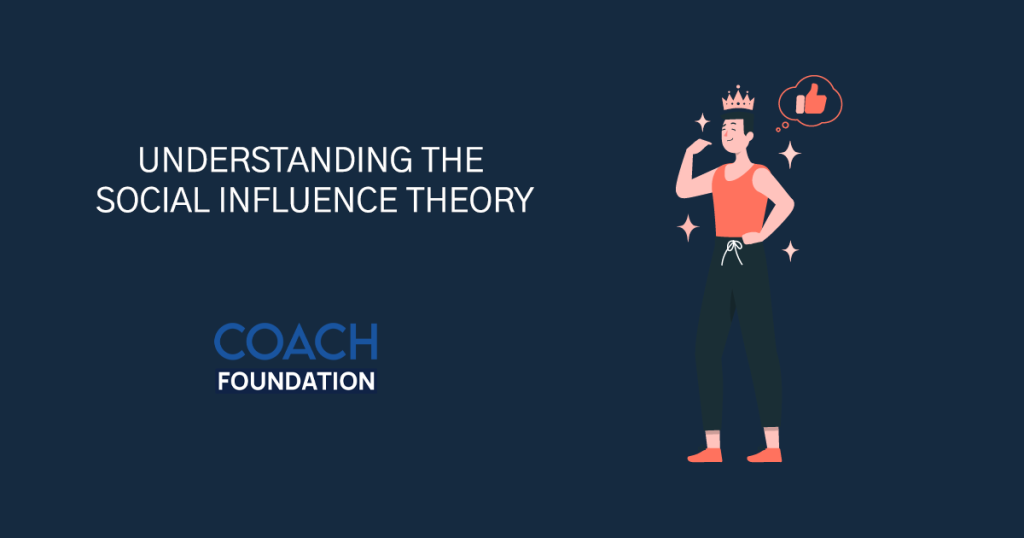Blog » Coaching Models and Techniques » Understanding The Social Influence Theory
Understanding The Social Influence Theory
Social Influence Theory is a psychological concept that explains how people’s thoughts, feelings, and behaviors are affected by the presence and actions of others. According to this theory, norms, conformity, obedience, and persuasion are just a few examples of the social factors that have an impact on people.

Norms are the unspoken rules that govern behavior in a group, and conformity is the practice of modifying one’s own actions or beliefs to fit in with those of the group. Both obedience and persuasion involve getting people to accept the viewpoint or actions of those in positions of authority over them. Social Influence Theory helps us understand how social factors can shape individual behavior and decision-making.
In this blog, we’ll explore:
1. What is the social influence theory
2. How does social influence theory work
3. Core Concepts of social influence theory
4. Application of social influence theory to life coaching
So, let’s get started!
What is the Social support theory
Social Influence Theory is a psychological theory that seeks to explain how social situations and the behavior of others can influence individual behavior, attitudes, and beliefs.
The theory suggests that people are motivated to conform to the expectations of others, especially when they perceive that those expectations are widely shared.
There are three main types of social influence: conformity, compliance, and obedience. Conformity refers to the tendency to change one’s behavior or beliefs to match those of a group, even if it goes against one’s own beliefs. Compliance refers to the tendency to go along with a request or demand from someone in a position of authority. Obedience refers to the tendency to follow the commands of an authority figure, even if it goes against one’s own moral code.
One of the best-known experiments that demonstrated the power of social influence was the Asch conformity experiment, conducted by Solomon Asch in the 1950s. In this experiment, participants were asked to judge the length of lines and were placed in a group where the majority intentionally gave the wrong answer. As a result, many participants conformed to the incorrect group answer, even though it contradicted their own perception.
Another famous example of social influence is Milgram’s obedience experiment, where participants were asked to administer electric shocks to a stranger who was actually an actor pretending to be in pain. Despite their discomfort, most participants continued to deliver the shocks when instructed to do so by an authority figure.
The Social Influence Theory is important in understanding how people’s behavior is shaped by their social environment and how individuals can be influenced by others to conform to their beliefs and expectations. The theory has been used to explain a wide range of social phenomena, from peer pressure and groupthink to cult behavior and political propaganda.
Check out this video to learn more about Social Influence!
How the social influence theory works
The term “social influence theory” refers to a body of thought that attempts to provide an explanation for how one’s peers can have an impact on one’s thoughts, feelings, and actions. The theory proposes three main mechanisms of social influence: conformity, compliance, and obedience.
Conformity occurs when individuals adjust their behavior or beliefs to match those of a group. For example, imagine a group of friends who all decide to wear a particular style of clothing. Even if one person in the group initially dislikes the style, they may conform to the group’s norms to fit in.
Compliance occurs when individuals change their behavior or beliefs in response to a direct request from another person. For example, a salesperson may use persuasive techniques to encourage a potential customer to buy a product they may not have initially wanted.
Obedience occurs when individuals follow the commands of an authority figure. For example, in the famous Milgram experiment, participants were asked to administer electric shocks to a person in another room, even though they believed the shocks could be fatal, simply because an authority figure (the experimenter) instructed them to do so.
Overall, social influence theory helps to explain how social norms are created and reinforced, and why individuals sometimes engage in behaviors that they might not otherwise. By understanding the mechanisms of social influence, we can better navigate social situations and make more informed decisions.
I went through this intriguing article explaining the workings of social influence theory, and I would suggest the readers go through it once!
Core concepts of social support theory
Like I said before, social influence theory suggests that people’s thoughts, feelings, and behaviors are influenced by the social environment around them. The theory proposes three main mechanisms of social influence: conformity, compliance, and obedience. Let’s examine the types, levels, and factors affecting social influence in detail.
Types of social influence
Social influence can occur in various forms, and three main types of social influence are compliance, identification, and internalization.
Compliance: It occurs when individuals change their behavior or attitudes in response to a direct request or pressure from others. For example, a person may comply with a request to donate money to a charity because their friends are doing so.
Identification: It occurs when individuals change their behavior or attitudes to be more like a particular person or group. For example, a person may start to dress like their favorite celebrity.
Internalization: It occurs when individuals adopt new beliefs or attitudes as their own because they see them as valid or desirable. For example, a person may adopt a vegetarian lifestyle because they have internalized the belief that it is more ethical and sustainable.
Learn about types of social influence in this article!
Factors that affect social influence
Several factors can affect social influence, including group size, social norms, authority, reciprocity, consistency, and liking.
Group size: It can impact social influence, with larger groups generally having more influence than smaller ones.
Social norms: Also called unwritten rules that govern behavior in a group, can also impact social influence by creating pressure to conform.
Authority figures: Such as teachers, bosses, or government officials, may have greater influence due to their perceived power and expertise.
Reciprocity: It refers to the expectation that favors will be returned, and can also be a factor in social influence.
Consistency: It is the degree to which an individual’s behavior or beliefs align with their past actions, which can increase credibility and therefore influence.
Liking: It is the degree to which an individual is liked or admired, and can increase social influence by creating a sense of connection and trust.
Check out this article to learn more about the factors affecting social influence.
Levels of social influence
Social influence occurs at various levels, ranging from broad social institutions to individual socialization.
Social institutions: Such as government, education, and religion, can shape social norms and values, and influence individual behavior through laws, policies, and cultural traditions.
Interactions with other people: Such as family, peers, and community members, can also influence behavior and attitudes through peer pressure, social support, and modeling.
Individual socialization: It is the process by which individuals learn the norms, values, and beliefs of their culture and society. This can occur through parental guidance, education, and cultural messages conveyed through the media and other sources.
A detailed overview of the levels of social influence can be inferred from this article!
Applying Social Influence Theory to Life Coaching
Understanding how a person’s social environment influences their thoughts, feelings, and behaviors will help you apply social influence theory to life coaching. Life coaches can use social influence theory to help clients identify and change behaviors that are negatively impacting their lives and develop positive habits that align with their values and goals.
Coaches can use various strategies to influence their clients, such as modeling positive behavior, providing social support and feedback, and framing requests in a way that aligns with the client’s values and interests. Coaches can also help clients understand the social norms and expectations that may be influencing their behavior and identify ways to break free from negative patterns of social influence.
For example, a life coach may work with a client who struggles with procrastination. The coach may use social influence theory to help the client identify the social norms and expectations that may be influencing their behavior, such as a belief that productivity is only valued if it is completed quickly. The coach may then help the client develop new habits and social support to counteract these negative influences, such as by scheduling regular check-ins with the coach or finding an accountability partner.
Overall, applying social influence theory to life coaching can help coaches better understand how to influence their clients in positive ways and help clients make lasting changes that align with their values and goals.
Conclusion
Understanding how a person’s social environment shapes their behaviors and attitudes using the social influence theory is helpful. It highlights the different factors that can impact social influence, such as group size, social norms, authority, reciprocity, consistency, and liking.
The theory also highlights the different levels of social influence, ranging from individual interactions to broader cultural and societal factors. By understanding these factors, individuals can better navigate their social environments and make conscious decisions about their behaviors and attitudes.
I am excited to receive your thoughts on this captivating blog and would appreciate it if you could share any additional insights or perspectives you may have in the comments section below.
Frequently Asked Questions (FAQs)
What is the concept of social influence theory?
The social influence theory provides a framework for understanding how people’s social environments affect their thoughts, feelings, and behaviors. It examines the various ways that other people can influence us, such as through peer pressure, social norms, authority figures, and media messages.
What are a few examples of social influence theory?
Examples of social influence theory include:
1. Peer pressure among adolescents is an example of social influence theory where individuals conform to the norms and values of their peer group to fit in and be accepted.
2. The influence of celebrity endorsements on consumer behavior is another example of social influence theory, where individuals are influenced by the opinions and preferences of others they admire and look up to.
3. Another illustration of the social influence theory, which holds that those in positions of authority or expertise can influence people, is the effect of authority figures on adherence to rules and regulations.
Who founded social influence theory?
The work of social psychologists like Kurt Lewin, Muzafer Sherif, and Solomon Asch served as the foundation for the development of social influence theory over time by a number of researchers.
Lewin, in particular, is often credited with founding the theory, as he conducted pioneering research on group dynamics and social influence in the 1930s and 1940s. Later researchers, such as Robert Cialdini, further expanded the theory and its practical applications in fields such as marketing, education, and public policy.

ABOUT SAI BLACKBYRN
I’m Sai Blackbyrn, better known as “The Coach’s Mentor.” I help Coaches like you establish their business online. My system is simple: close more clients at higher fees. You can take advantage of technology, and use it as a catalyst to grow your coaching business in a matter of weeks; not months, not years. It’s easier than you think.
AS SEEN ON





